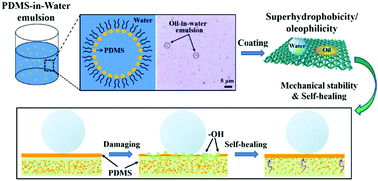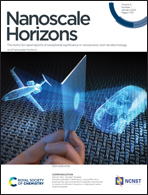A “PDMS-in-water” emulsion enables mechanochemically robust superhydrophobic surfaces with self-healing nature†
Abstract
It is highly challenging to construct a durable superhydrophobic coating for practical applications since the coating is easily destroyed by mechano-chemical attack. To address this issue, a “PDMS-in-water” emulsion approach is for the first time adopted to design a mechanochemically robust superhydrophobic cotton fabric with intelligent self-healing nature, without using any fluorine-containing components. With this approach, PDMS molecules firstly penetrate into the cotton fiber, and then graft onto the surface of the cotton fabric with a strong binding force, creating hierarchical rough structures and lowering the surface energy simultaneously. Benefitting from this design, the PDMS@cotton fabric exhibits high superhydrophobicity with a water contact angle over 155°, surpassing all the PDMS-in-organic solvent based approaches. Impressively, the surface repairs its superhydrophobicity throughout the whole lifetime though damaged by machine washing or abrasion (>100 cycles), due to the self-diffusion process of PDMS molecules from the inner part to the outer surface of the cotton fibers to minimize surface free energy. Besides, the superhydrophobic coatings display superior chemical stability in strongly acidic and alkaline solution, and maintain similar textile physical properties of the cotton fabric, such as elongation at break, tensile strength, etc. Our environment-friendly “PDMS-in-water” approach can be easily integrated into industrial textile finishing treatment and is promising to apply to various substrates with robust superhydrophobic surfaces.



 Please wait while we load your content...
Please wait while we load your content...